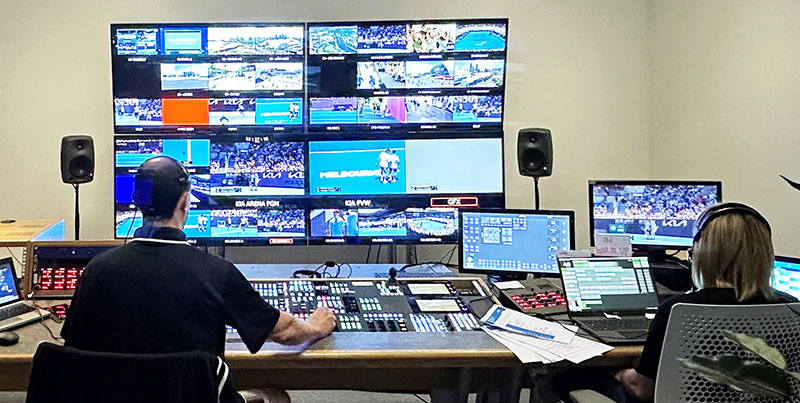Gravity Media and Tennis Australia’s coverage of the Australian Open, their most complex to date, deployed Sony 4K system cameras, Grass Valley connectivity and EVS asset management.

Gravity Media and Tennis Australia expanded their broadcast and technology partnership used to deliver the Australian and international all-screens coverage of this year’s Australian Open, held 16-29 January.
This was Gravity Media’s 9th year in this role for the Australian Open in Melbourne, and its 19th year as the host broadcast technical provider for the entire 2023 Summer of Tennis tournament.
Building on the existing agreement, Gravity Media has also worked in partnership with Tennis Australia to deliver the global coverage of the United Cup played in Brisbane, Perth and Sydney in the lead-up to The Australian Open, and also supplied the broadcast and technology equipment and expertise for coverage of this year’s Adelaide International.
Total Technical Facility
“In 2005 we delivered our first total technical facility for the host broadcast of the Australian Open,” said Kevin Moorhouse, Advisor from Gravity Media. “Our role and the requirements for Tennis Australia have evolved substantially over the past 19 years and this year’s event is the biggest and most complex operation we have undertaken.

“We have created and managed 1080i, 1080P and UHD coverage across multiple courts and the entire precinct, and ensuring the delivery of these multiple signals to the host broadcast along with unilateral feed requirements for Tennis Australia’s broadcast partners."
4K System Cameras
Across the full venue, 165 cameras were in use including Sony HDC 3500/4300 channels, along with various robotics systems that used Sony P43, Hitachi DKH 200 and Panasonic robotic cameras with Mark Roberts PTZF heads. To cover the entire area, a number of receive sites allowed 16 roving RF cameras to work anywhere within the venue, while two remote RF robotic cameras were capturing broader views of Melbourne.
The HDC 4300, Sony’s 4K camera for UHD live productions, was one of the world’s first 4K system cameras. It records HDR images in the BT.2020 colour gamut, with high frame rate capture at 2x in 4K, and 8x in HD. The HDC 3500 is a portable system camera with a 2/3-inch 4K global shutter, three-CMOS sensor system and double-speed acquisition functionality in HD.
The production facilities are housed at Tennis Australia’s headquarters in Melbourne, connected via 500m of fibre to the central apparatus room. The production facilities consist of seven production galleries using Grass Valley Kahuna Maverik switching panels, and six audio control rooms using Calrec Artemis audio consoles. Gravity Media also set up ten ViBox vision mixer systems to handle coverage on the ten outside courts.

System Connectivity and Data Management
To achieve system connectivity, Gravity Media was using a large IP-based fly-away system with a provision for baseband usage, to set up a system that is effectively a 3900 x 3500 video router. An integrated audio system, between a Grass Valley Audio Live router for live multistream IP audio processing and Calrec cores, made it possible to route over 2,500 audio signals within the facility. The Calrec Artemis’ control surface incorporates colour, touch and tactile controls that operators can reconfigure to match various operating setups.
All slo-motion replays, plus archiving and media management, were achieved using 25 EVS servers, and 52 EVS IPDirector content management systems. They also had four of the high performance DB servers, which are EVS database SQL servers used to manage large EVS network systems, and host the IPDirector database.
XTAccess transcoding and rewrapping software facilitated media interchange between EVS production systems and third-party switchers, storage, file-based camcorders and so on. XTAccess handles automatic media-conforming operations such as transcoding on-the-fly, media rewrapping and playlist rendering – to ease media interchange. XFile3 software gives immediate access to and archiving of EVS server content during the event. The team could archive, transform and restore selected content in any format and from multiple destinations.

During any day’s play, Gravity Media would deliver 25 to 45 streams to the 900 Tb of storage on site, and from there, all the action could be accessed by the host and unilateral broadcasters.
Summer of Tennis Events
In the lead-up to the Australian Open, Gravity Media supported Tennis Australia in setting up facilities for the United Cup mixed teams tournament in its inaugural year, as well as the Adelaide International.
In each city holding United Cup events – Brisbane, Perth and Sydney – Gravity Media supplied outside broadcast production trucks and facilities accessing 28 cameras and multiple EVS replay and edit suite facilities, along with the Xeebra replay system for teams and players in the United Cup to use.

Throughout the event, further specialised Gravity Media fly-away production systems were implemented in Sydney to bring together coverage from multiple cities. This made it possible to create a completely integrated and produced world feed for delivery across many different broadcast and subscription platforms in international markets.
The Adelaide International accessed one of Gravity Media’s HD production trucks and the company’s fly away production systems combined with 27 cameras across multiple courts to deliver bespoke coverage feeds for Tennis Australia and its domestic and international broadcast partners. www.gravitymedia.com




















